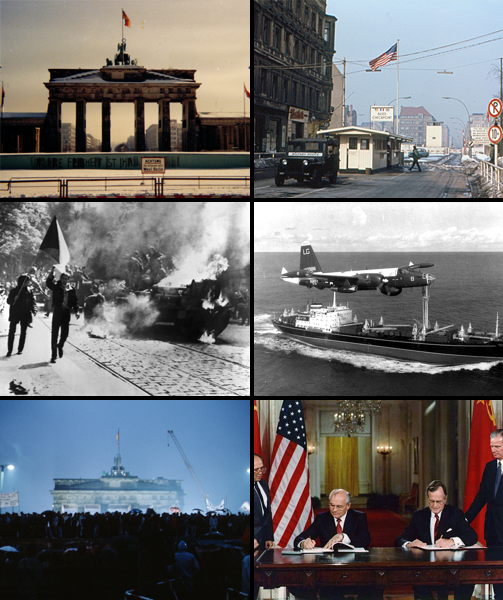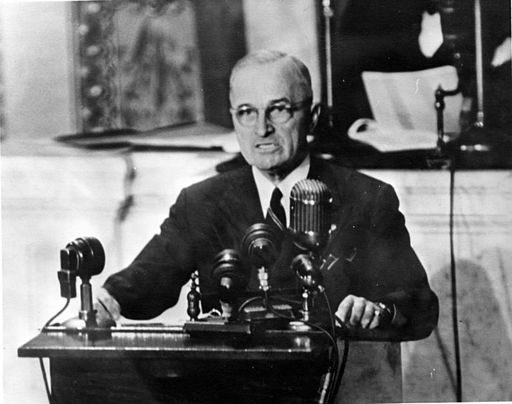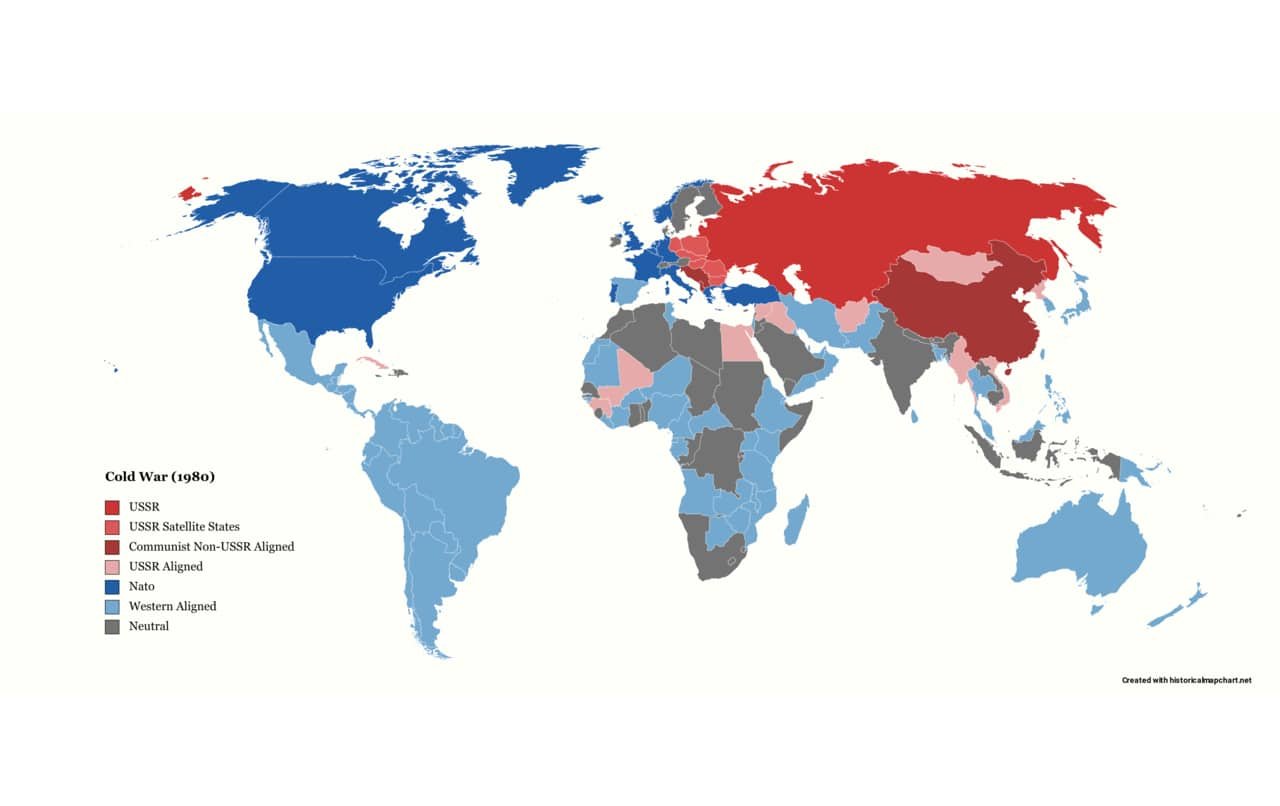Cold War March 12, 1947 – Dec. 26 1991
The Cold War began from the end of the Second World War. It will last until the dislocation of the USSR in December 1991.
The Cold War gradually set in from the end of the Second World War in the years 1945 to 1947 and lasted until the fall of communist regimes in Europe in 1989, quickly followed by the breakup of the USSR in December 1991.
At the end of the Second World War, the Allies reorganized Europe and decided the fate of defeated Germany, divided into four areas of occupation. Throughout the 20th century, two superpowers clashed: the United States and the USSR, it is American democracy in the face of Soviet communism. These two powers possess nuclear weapons, the confrontation can degenerate into World War III with atomic consequences.
The 2 “blocks”, each of which has powerful allies, never directly oppose each other. But history could have changed several times (Korean War, Cuba crisis, etc.). An invisible “iron curtain” symbolically separates the two blocks. In Berlin, the main theater of the Cold War, it is materialized by a “wall of shame”.
What are the main causes of the Cold War?
The roots of the Cold War date back to the October Revolution of 1917, from which the Soviet Union was born in 1922. The difficult relations between the United States and the Soviet Union stem from the very nature of their political regimes and the ideologies that underpin them.

Left to right, top to bottom: Brandenburg Gate behind the Berlin Wall, Checkpoint Charlie, Prague Spring, Jan Palach, protests at the Brandenburg Gate, George HW Bush and Michail Gorbachev signing the arms limitation agreements chemical. AlexTref871, CC BY-SA 4.0, via Wikimedia Commons
What event marked the Cold War and key dates?
1945: the Yalta conference
From February 4 to 11, Churchill, Stalin and Roosevelt met in Yalta, Crimea (Russian resort town), to decide the fate of defeated Germany. They decide on the modalities of occupation of Germany, divided into four areas of occupation.
Berlin, in the Soviet zone, will also be divided into four sectors. If the Yalta conference led to the USSR’s entry into war against Japan and the creation of the United Nations (UN), it was followed, in July and August of the same year, by the Potsdam conference, where the atmosphere is more tense. Indeed, the Red Army has established communist governments in all countries liberated by the Soviets, which the Americans do not see very favourably.
March 12, 1947: the Truman Doctrine
U.S. President Harry S. Truman presents to Congress his doctrine of containment, which aims to provide financial and military assistance to countries threatened by Soviet expansion, such as Greece and Turkey. This doctrine, the reaction of a free world to Soviet aggression, justifies the interference of the United States in the affairs of democratic countries. Truman thus broke with the policy of his predecessor, Franklin D. Roosevelt, and redefines the foreign policy of the United States. Isolationism gives way to interventionism.

Special Message to Congress on Greece and Turkey The Truman Doctrine. President Harry S. Truman addressing a joint session of Congress asking for $400 million in aid to Greece and Turkey. This speech became known as the “Truman Doctrine” speech. Harry S. Truman Library & Museum, Public domain, via Wikimedia Commons
June 5, 1947: the Marshall Plan
After the Second World War, Europe was in a bad economic situation. Anxious to raise the European economy to ensure US exports, but also to avoid the Soviet temptation, US Secretary of State George C. Marshall offers all European countries economic and financial assistance in a speech delivered at Harvard on June 5, 1947. This is the Marshall Plan. On April 16, 1948, the sixteen countries that accepted it signed the Convention establishing the Organization for European Economic Cooperation (OEEC) in Paris.
September 22, 1947: the Jdanov doctrine
On September 22, 1947, delegates from the communist parties of the USSR, Poland, Yugoslavia, Bulgaria, Romania, Hungary, Czechoslovakia, Italy and France met near Warsaw. They create the Kominform, a way for the USSR to closely control the communist parties in the West.
The content of the doctrine proposes that the world is divided into two camps: the “imperialist” camp led by America and the “democratic” camp led by the Soviet Union.
Stalin’s right-hand man, Andrei Jdanov, states that the world is now divided into two camps: an “imperialist and anti-democratic” camp, led by the United States, and an “anti-imperialist and democratic” camp, led by the USSR. This Jdanov doctrine is a response to the Truman doctrine and confirms a situation that has set to last: the world is bipolar.
1948-1949: the blockade of Berlin
In 1947, the English and Americans merged their areas of occupation and set up a single currency. Concerned about the reconstitution of a Germany that would be hostile to him, Stalin established a blockade to prevent the supply of the two million Berliners who lived in the West on June 24, 1948. All communication routes are cut off and controlled by the Soviets, except the airway.
American General Clay took the opportunity to set up an airlift and supply the city: for nearly a year, West Berliners received more than two million tons of food and coal. It is clear for Stalin that his blockade is a failure. He lifted it on May 12, 1949.
June 25, 1950: Korean War
Communist troops in North Korea cross the 38th parallel that separates the north, under Soviet influence, and the south, under American influence. The United States engages the United Nations (UN) in the defense of South Korea and an international force composed of sixteen countries is being formed.
American General MacArthur would have liked to use nuclear weapons against Communist China, an ally of North Korea, which multiplies counter-offensives. By refusing to use the atomic bomb, President Truman avoids a new world conflict. The Korean War continued until the signing of an armistice in July 1953.
August 1961: construction of the Berlin Wall
East Germans (GDR: German Democratic Republic) envy the economic prosperity and freedom of expression of the inhabitants of West Germany (FRG: Federal Republic of Germany). After the failure of the 1953 revolt, hundreds of thousands of them pass to the West. In less than ten years, this exodus affects more than two million Germans. To stop this massive and continuous phenomenon, the GDR prevents the passage to the West by building, on the night of August 12 to 13, 1961, the famous “Berlin Wall”. Its intensive surveillance discourages any attempt at transgression, even if some will still risk it.
Berlin Wall and History From its Rise, Fall and Reunification
October 1962: Cuban crisis
Since the revolutionary overthrow of Batista’s military dictatorship in January 1959, Cuba has been governed by Fidel Castro. The latter is getting closer to the USSR by signing various trade and then military cooperation agreements. With the landing of anti-Castro exiles in Pig Bay, the United States tried to overthrow Castro’s regime in April 1961, but the operation failed.
Read also: Latin American Countries and Caribbean
On October 14, 1962, American planes spotted Soviet cargo ships loaded with missiles and rocket launch ramps heading for Cuba. In response, Kennedy closes all maritime access routes to Cuba. The blockade works. On October 28, Soviet ships left in exchange for which the Americans pledged to leave Cuba in peace and withdraw their own rockets from Turkey. Nuclear war was narrowly avoided.
April 1985: perestroika and democratization
A wind of democratization is blowing over the Eastern bloc. The head of the USSR, Mikhail Gorbachev, is implementing a policy of transparency (glasnot) and restructuring of the Soviet regime (perestroika) to reform the Soviet Union by reconciling socialism and democracy. In the spring of 1989, he elected a Congress of People’s Deputies, responsible for electing the Soviet Head of State and was elected to this position on May 22, 1989. He ousts Brezhnev’s supporters, continues the process of destalinization begun by his predecessor Khrushchev and guarantees new freedom of expression to his people.
November 9, 1989: fall of the Berlin Wall
On November 9, 1989, following important popular demonstrations in the East, the “wall of Shame” was announced “permeable”. The first physical destruction of the Wall begins in the process. Between laughter and tears, scenes of jubilation between strangers from the East and West who fall into their arms, are broadcast on television. On October 3, 1990, it’s official, the two Germanys become one. The Berlin Wall, opened on the evening of November 9, 1989, was completely demolished in November 1991.
December 26, 1991: dissolution of the USSR
“Dissolution”, “dislocation”, “burst”, “collapse”, whatever the term used, December 26, 1991 marks the end of the Union of Soviet Socialist Republics (USSR) after 69 of existence (it was founded on December 20, 1922). Mikhail Gorbachev, eighth and last Soviet leader, had resigned the day before and transferred his powers to the President of the Russian Federation, Boris Yeltsin.
Sources: PinterPandai, History, Britannica, John F. Kennedy Presidential Library and Museum, National Geographic
Photo credit: NightRider6658 (CC BY-SA 4.0) via Wikimedia Commons
Oppenheimer Julius Robert | Father of the atomic bomb and his regrets



